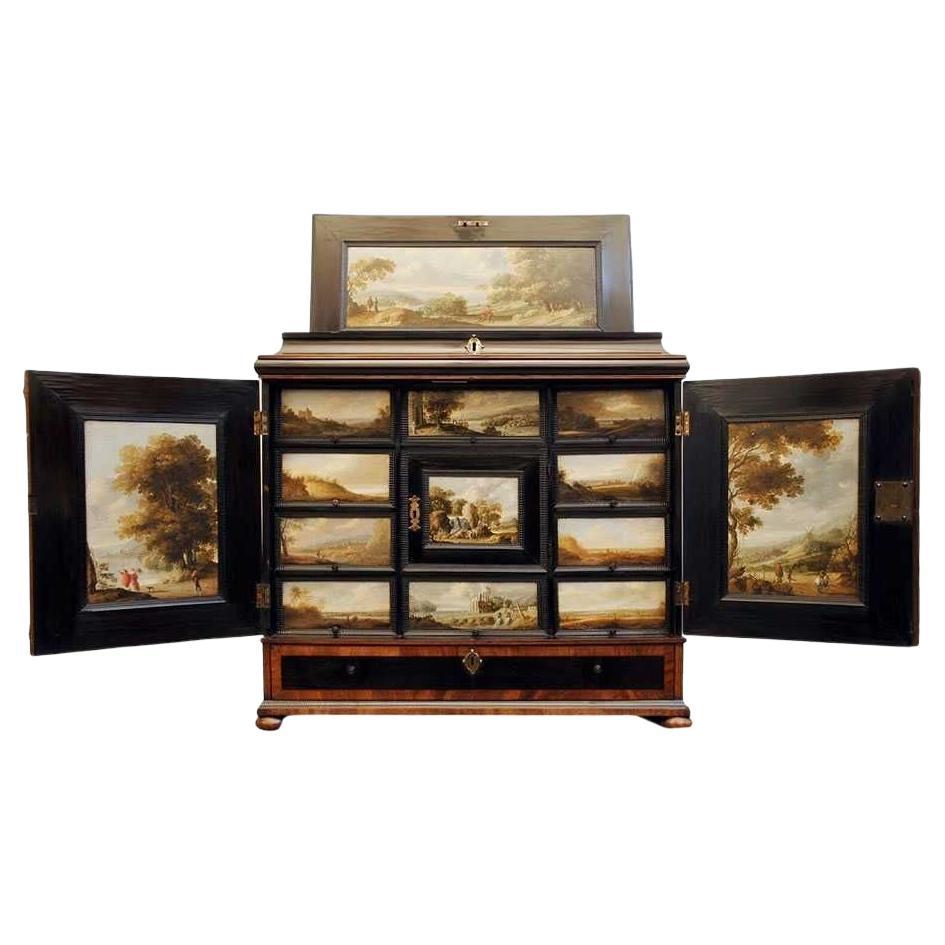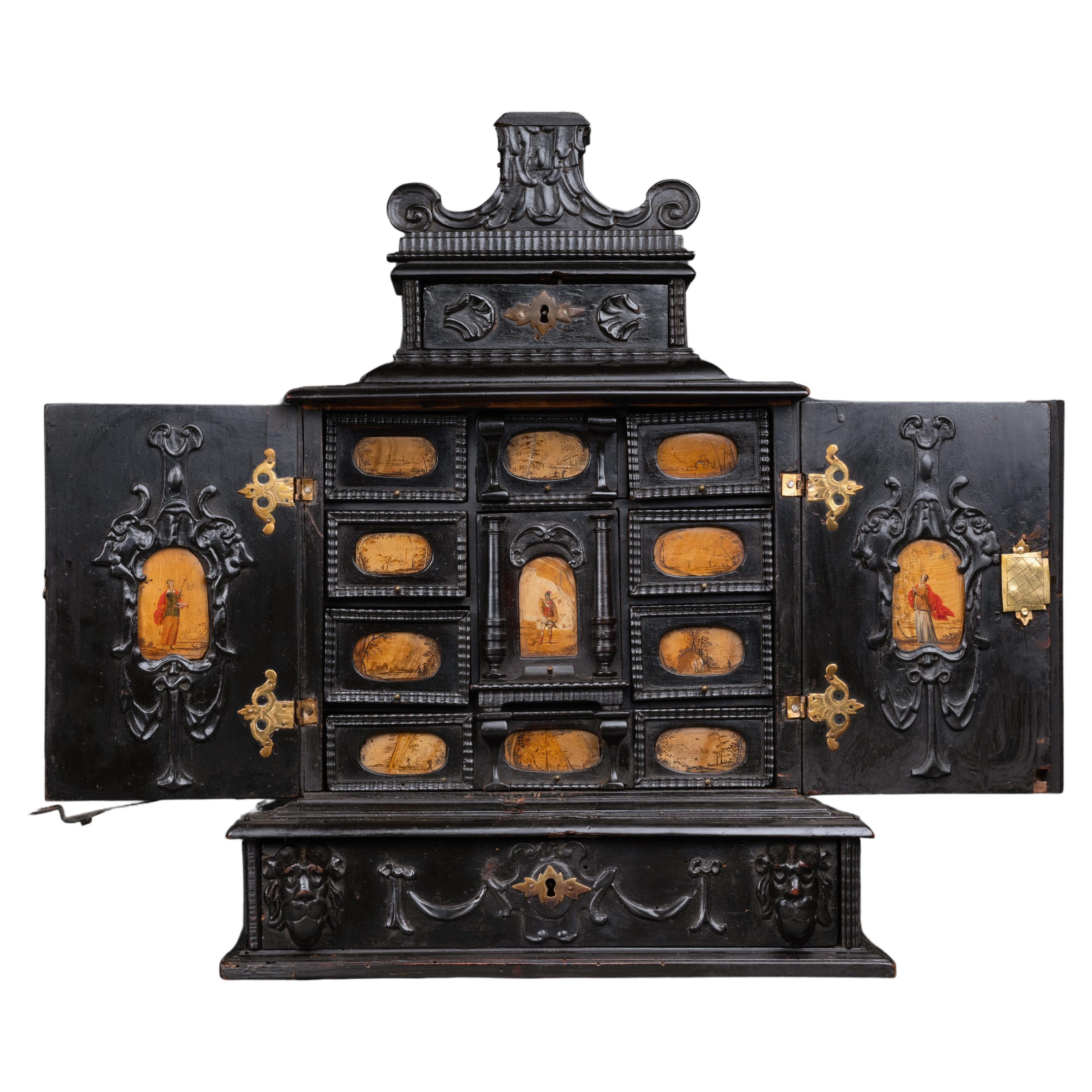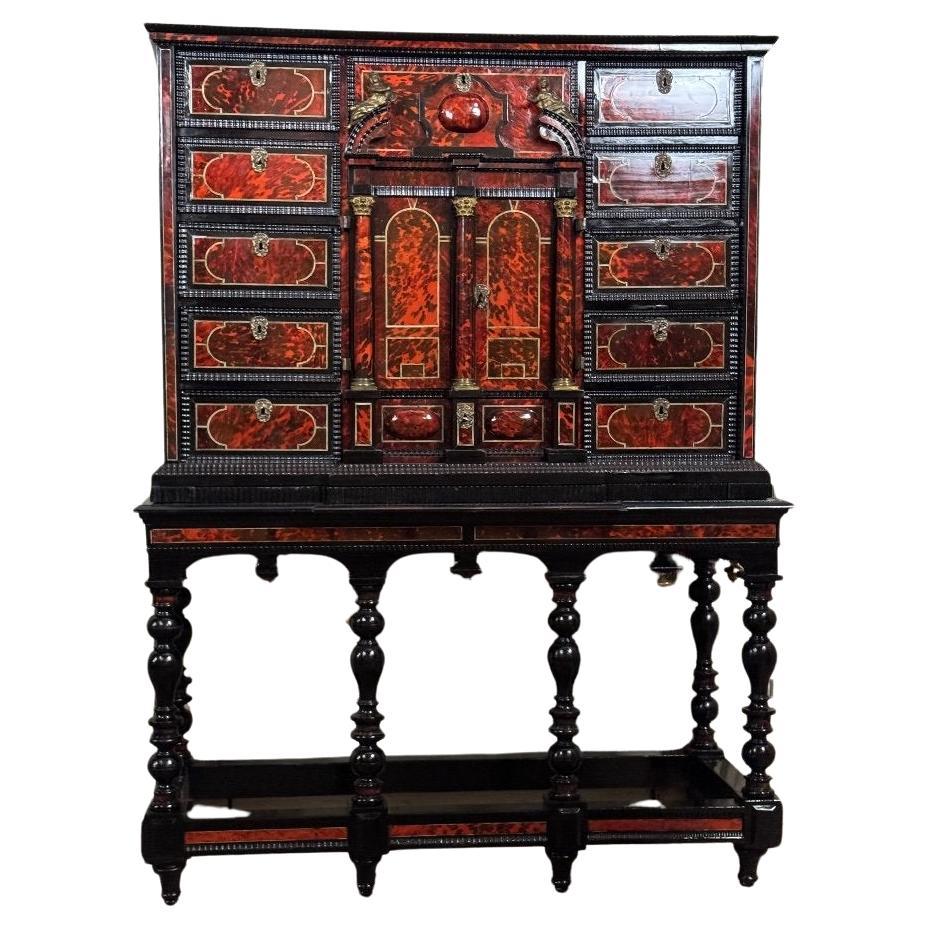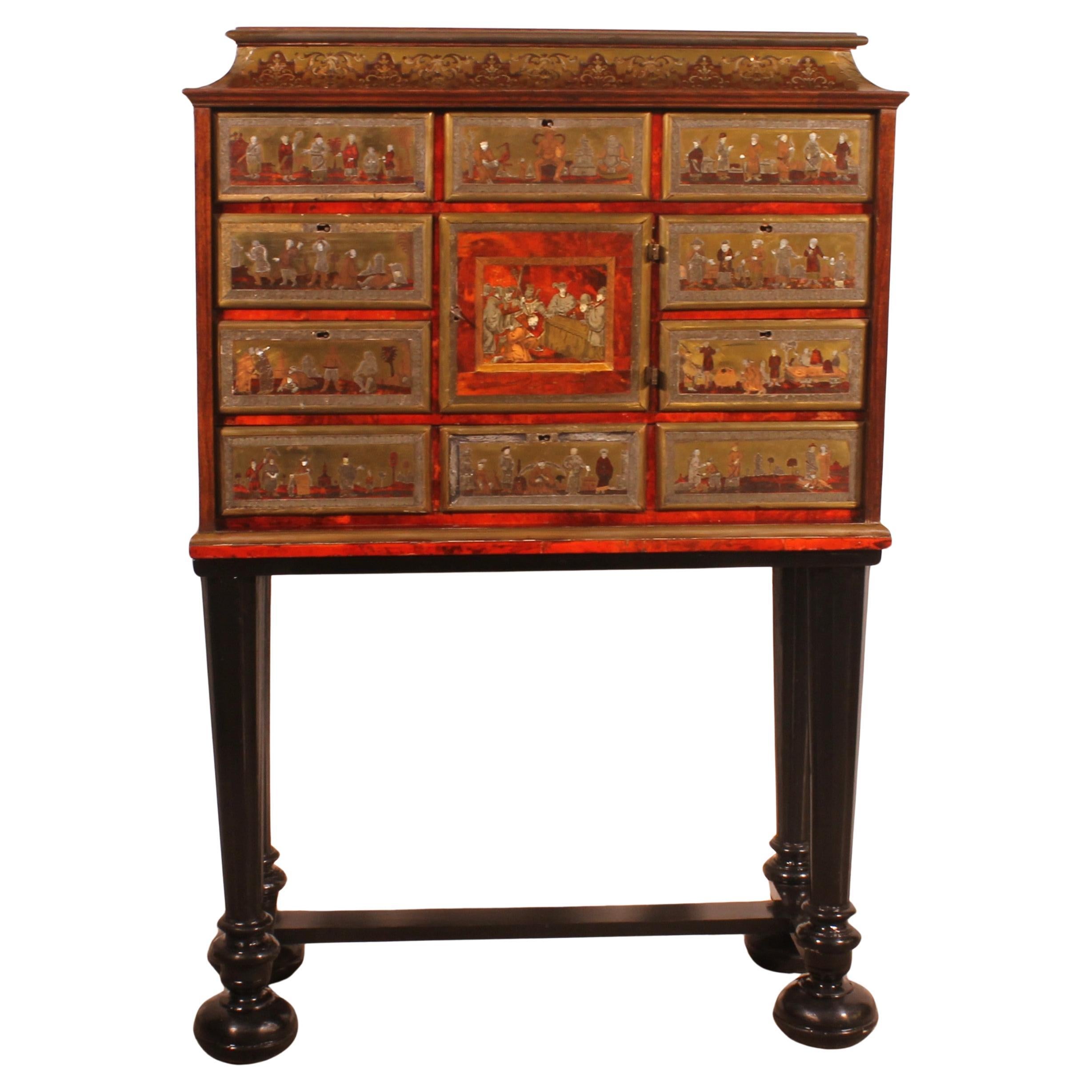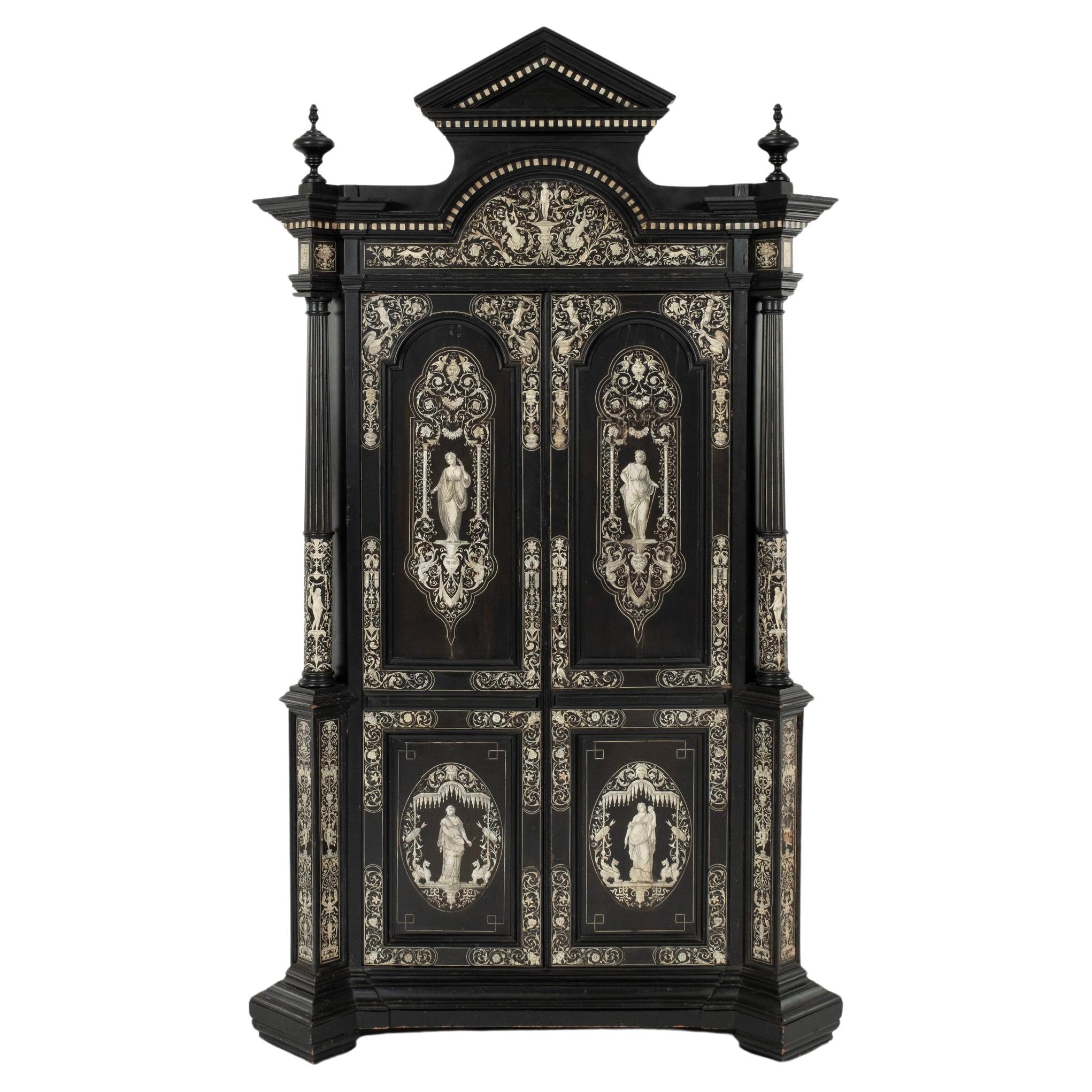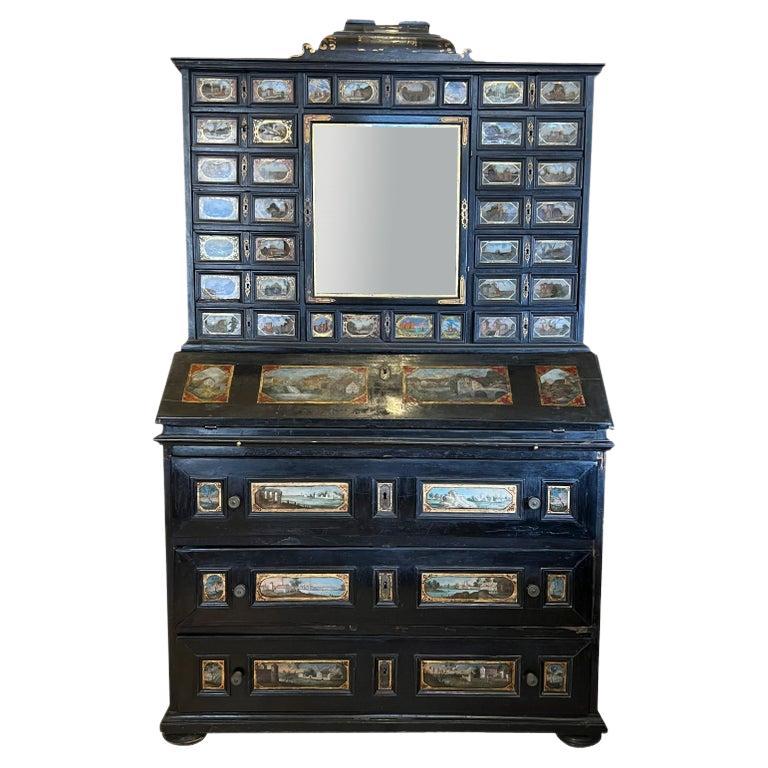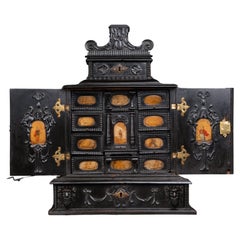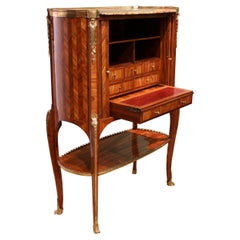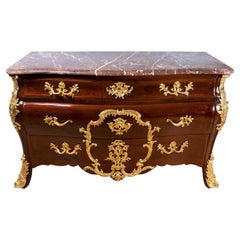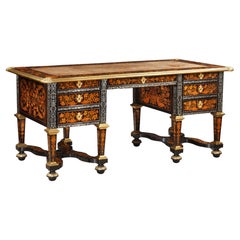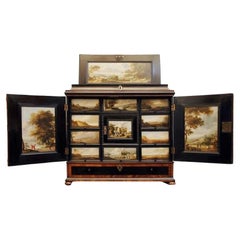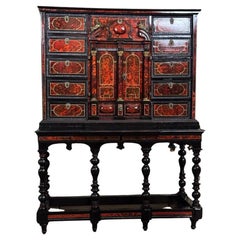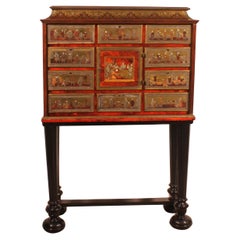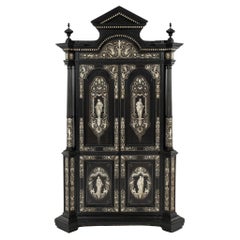Items Similar to 17th century ebonized Antwerp cabinet with painted panels, circle 1630
Want more images or videos?
Request additional images or videos from the seller
1 of 18
17th century ebonized Antwerp cabinet with painted panels, circle 1630
$76,860.92
£57,646.38
€65,000
CA$107,614.90
A$118,621
CHF 61,292.28
MX$1,418,030.19
NOK 771,052.77
SEK 724,679.81
DKK 495,202.62
About the Item
Cabinet
Antwerp, circa 1630, 17th century
Paintings on wood:
Circle of Hendrick van Balen (Antwerp, 1573–1632)
Dimensions: h. 86 cm, l. 102 cm, p. 47cm
This precious cabinet is one of the rare, emblematic works of the city of Antwerp, produced thanks to the collaboration between a painter and a master cabinetmaker, and intended to adorn Kunstkammers (private museums) or art lovers' cabinets.
Our cabinet is decorated with 13 painted panels with mythological and allegorical subjects and perfectly reflects the Antwerp pictorial trends of the early 17th century. Definitely in the spirit of the times, where one of the roles of amateur cabinets (the room for which it is intended) is to be able to contemplate the world in all its aspects.
It opens with two doors revealing 10 drawers, 9 of which have painted panels on the front, a central door and an upper compartment whose interior is also decorated with a painted panel.
The left door presents a theme frequently treated in the 17th century, the allegory of the four elements that make up the universe: air, water, fire and earth. They are personified by young women displaying the attributes of the four kingdoms of nature. The armillary sphere for Air, a lit torch for Fire, the flowerpot for Earth and an urn for Water. In the foreground on the ground are placed objects evoking the art of fire: a pile of pieces of armor and weapons, on a table clocks and dishes. In the background we see Vulcan's forge.
The door on the right illustrates the allegory of Autumn in the guise of Roman divinities. Bacchus with a cup, Ceres with the cornucopia and Venus seen from the back and naked are gathered in a landscape while Diana presents them with the game. The fruits and vegetables placed at their feet evoke the richness of the harvest.
The small central door illustrates the Allegory of Vanity, personified by a young woman holding an oil lamp from which smoke escapes (the flight of time), the putto blowing soap bubbles (signifying the fragility of life) is seated on a skull, symbol of death.
The panel in the upper compartment illustrates the allegory of the five senses personified by young women gathered around a table filled with various dishes and each holding an attribute. The parrot for Touch, the mirror for Sight, the cup for Taste, the flower for Smell and the lute for Hearing.
This representation of the world through a cabinet continues with the choice of subjects used for the drawer panels which are directly inspired by Ovid's Metamorphoses engraved by Antonio Tempesta. These engravings published in 1606 considerably increased the mythological pictorial repertoire and quickly became the source of inspiration for Antwerp artists.
The subjects present:
Left side from top to bottom:
• Vertumnus and Pomona
• Apollo pursuing Daphne
• The suicide of Thysbe
• The death of Adonis
Right side from top to bottom:
• Procris Offering the Javelin of Artemis to Cephalus
• Adonis Contemplating the Sleeping Venus
• Latona Transforming the Lycian Peasants into Frogs
• Ceneus and Poseidon
The Central Drawer: Glaucus Seduced by Scylla
The stories contained in “The Metamorphoses” were perfectly suited subjects for cabinets of curiosities whose function was to reflect and explain the world and its origins through a mythological, not a biblical, vision.
A cabinet with almost identical paintings also attributed to the circle of Hendrick Van Balen, was sold at Christie's London, 27/10/2015, lot 226.
See also another cabinet attributed to Hendrick Van Balen, sold at Christie's London on December 8, 2011, lot no. 107, some of whose panels are very similar to ours (the allegory of Vanity, Glaucus seduced by Scylla, Pomona and Vertumnus).
The Philadelphia Museum of Art holds a series of small panels by Hendrick Van Balen from a cabinet, two of which have the same subject and are similar to our panels.
In addition to the fabulous painted decoration, our cabinet is executed with refinement and use of expensive materials. It displays a sober but neat exterior, in ebony veneer and embellished with frames of wavy moldings and appliquéd silver applications. Once opened, the small door reveals a compartment composed of a series of drawers framing a theater designed by alternating mirrors and half-columns in gilded wood with at the bottom two paintings on wood representing an elegantly dressed gentleman and noble lady. The floor is a checkerboard of ebony and ivory.
Following the classical design, it has two drawers in the belt.
Historical context:
In the 17th century, Antwerp was the leading European center for the manufacture of cabinets with painted panels. Illustrations of contemporary interiors show that these were presentation furniture, often in ebony veneer on the outside which once opened amazed by the richness of their small oil paintings. These cabinets were intended to house collections of jewelry, silver, minerals, shells and other specimens, in keeping with the princely tradition of kunstkammer (private museums).
For example, we find a similar cabinet in a painting by Frans Francken's workshop "Achilles among the daughters of Lycomedes" dated to the end of the 1620s ( Musée du Louvre, Paris inv. RF1535 ). Among all the riches that the merchants brought to the king of Lycomedes, there is an ebony cabinet with painted panels.
It is obvious that a cabinet as the one we're offreing was one of the centerpieces of amateur cabinets and thanks to its many drawers an ideal place for storing all the precious objects belonging to collectors.
- Dimensions:Height: 33.86 in (86.01 cm)Width: 40.15 in (101.99 cm)Depth: 18.5 in (46.99 cm)
- Style:Baroque (Of the Period)
- Materials and Techniques:
- Place of Origin:
- Period:
- Date of Manufacture:circa 1630
- Condition:Wear consistent with age and use.
- Seller Location:PARIS, FR
- Reference Number:1stDibs: LU8168243512122
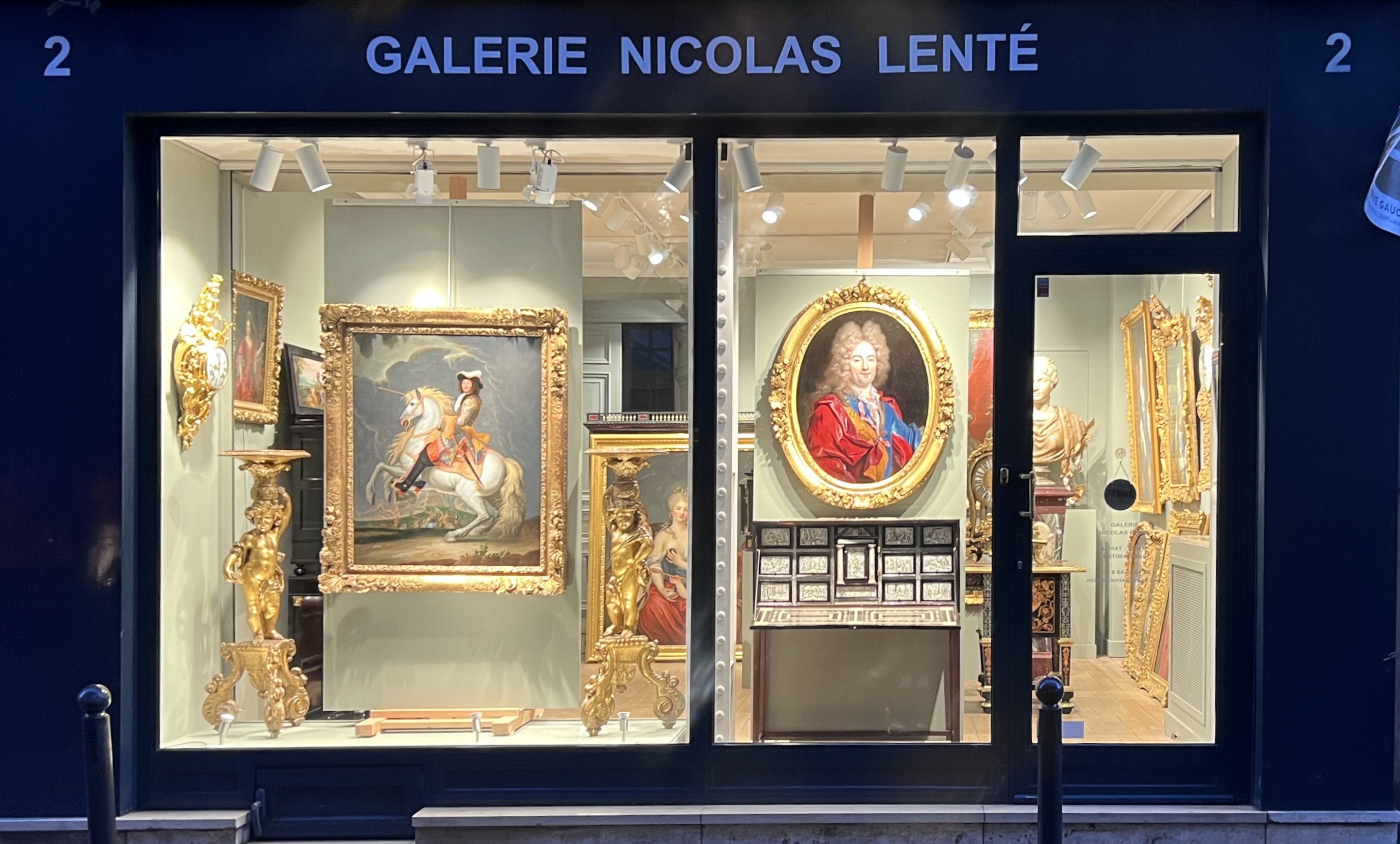
About the Seller
No Reviews Yet
Vetted Professional Seller
Every seller passes strict standards for authenticity and reliability
Established in 2011
1stDibs seller since 2023
- ShippingRetrieving quote...Shipping from: PARIS, France
- Return Policy
Authenticity Guarantee
In the unlikely event there’s an issue with an item’s authenticity, contact us within 1 year for a full refund. DetailsMoney-Back Guarantee
If your item is not as described, is damaged in transit, or does not arrive, contact us within 7 days for a full refund. Details24-Hour Cancellation
You have a 24-hour grace period in which to reconsider your purchase, with no questions asked.Vetted Professional Sellers
Our world-class sellers must adhere to strict standards for service and quality, maintaining the integrity of our listings.Price-Match Guarantee
If you find that a seller listed the same item for a lower price elsewhere, we’ll match it.Trusted Global Delivery
Our best-in-class carrier network provides specialized shipping options worldwide, including custom delivery.More From This Seller
View AllA 17th century Augsburg ebonized cabinet with painted pietra paesina panels
Located in PARIS, FR
An ebonized wood cabinet with painted pietra paesina panels
Augsburg, southern Germany, mid-17th century
Dimensions: h. 43 cm, w. 32 cm, d. 20 cm
Ebonized wood, inlay of painted piet...
Category
Antique Mid-17th Century German Renaissance Cabinets
Materials
Marble
$12,013 Sale Price
20% Off
French 18th C. Louis XV/XVI Transitional Ormolu Mounted Secretaire by RVLC
By Roger Vandercruse dit Lacroix
Located in PARIS, FR
A Louis XV/XVI transitional ormolu mounted tulipwood secretaire by RVLC
Rare and elegant secretary of elliptical shape, veneered on all sides of rosewood with herringbone decoration...
Category
Antique 18th Century French Louis XV Secretaires
Materials
Bronze
$30,153 Sale Price
25% Off
French 18th Century Regence Ormolu-Mounted Commode by Etienne Doirat
By Etienne Doirat
Located in PARIS, FR
A Regence ormolu-mounted commode by Etienne Doirat (Paris, 1675-1732)
Rare and elegant commode curved on the front and on the sides, in amaranth veneer arranged in sheets in the frames. It opens with four drawers in three rows: two large and two short and asymmetrical .
Rich ornamentation of chiseled and gilt bronzes: the Rococo frontal cartouche, mounts with oak leaf windings, foliated handles and clogs, rosettes on the sides.
Flanders red marble top.
Size: h. 35.04 inch, w. 56.69 inch, d. 33.46 inch
By Etienne Doirat (1675-25 June 1732), Regency period, 18th century
Although not stamped, our commode belongs by its shape and its bronze ornamentations to an identified corpus of the production of Etienne Doirat, one of the most talented cabinetmakers under the Regency.
This group of chests of drawers listed in public and private collections, some of which stamped E. Doirat are characterized by the almost identical front cartouche.
On our chest of drawers, this cartouche is formed by two scalloped lambrequins joined by a clip they are extended by branches with acanthus foliage and flowers with beaded friezes. Inside are two keyholes, the first with a lion's mouth, the second formed by two stylized dolphins facing each other with lion's paws under a valance.
Chests of drawers by Etienne Doirat with the frontal cartouche:
Commode in identical "tombeau" shape:
- Commode stamped Doirat, Christie's London, July 10, 2008 lot n 43
- Unstamped chest of drawers, doc. Me Tajan, published in "French 18th century Furniture" by Kjelleberg
Commode of different shape, identical front cartouche:
- Chest of drawers with three drawers, stamped Doirat, Christie's London, November 27, 2018 lot n 509
- Sarcophagus chest of drawers, stamped Doirat, J. Paul Getty museum, Los Angeles
- Chest of drawers with two drawers, stamped Doirat, private collection, illustrated in J. - D. Augarde
- Chest of drawers with three drawers, stamped by Migeon, but attributed to Doirat from the former Eugène Kraemer collection, sale at Galerie Georges Petit (Paris), May 5-6, 1913, lot 141; former Ogden Mills collection, Paris, rue de Varenne...
Category
Antique Early 18th Century French Régence Commodes and Chests of Drawers
Materials
Marble, Bronze
$36,213 Sale Price
30% Off
A rare French Louis XIV large pewter and fruitwood inlaid marquetry desk
By Pierre Gole
Located in PARIS, FR
A rare French Louis XIV large pewter and fruitwood inlaid marquetry desk called “bureau Mazarin” attributed to Pierre Gole (1620 – 1684)
Dimensi...
Category
Antique Late 17th Century French Louis XIV Desks and Writing Tables
Materials
Bronze, Pewter
A 16th Century Renaissance Cavred Walnut Buffet Loire Valley
Located in PARIS, FR
A 16th Century French Renaissance Cavred Walnut Buffet Loire Valley
Dimensions: H. 1m62; L. 1m02; P. 0.52m. (63.78 in. x 40.16 in x 20....
Category
Antique 16th Century French Cupboards
Materials
Walnut
A large and exceptional 15th c. Gothic leather and iron bound travelling chest
Located in PARIS, FR
Large leather and iron bound travel chest, very rare in its dimensions
Late 15th century, Northern France
Dimensions: h.103 cm, w. 178 cm, d. 77cm ( (H. 40.55 in, w. 70.08 in. d. 30.31 in)
Our rectangular-shaped chest opens with a rounded lid. It is entirely covered in leather veneered on a wooden core, and decorated with wrought and crafted iron frames and hinges.
It is garnished on all sides with iron hinges cut at the ends of Gothic trefoils.
On the facade two lock plates with cut-out cloverleaf borders fitted with a hasp (one missing) attached to the cover.
The iron bands serving as reinforcements on all sides as well as the central bands are decorated with plant and floral friezes and geometric patterns. These strips are attached to the wood using daisy-headed nails, typical of the French Renaissance.
Given its size and loaded weight, our trunk has four carrying handles: two wrought iron side handles, but also two front handles.
The interior has a stretched fabric dating from at least the 17th century, we find on the interior sides of the cover the original raspberry-colored vellum.
This is a rare model in leather and iron of very large dimensions. Expensive materials, which were only used on small Gothic boxes (20 cm to 50 cm in length) like those in the public collections of many museums.
Large chests exceeding 1 meter in length for the sake of economy and simplicity were generally made of wood sometimes covered with iron cladding.
We found a large chest in the collections of the Metropolitan Museum of New York, but still smaller than ours (inv. 47.144, dim. H: 22 1/2" W: 50 1/2" D: 21").
There are also two similar large chests (with flat or slightly domed lids) in the collections of the Barcelona Leather...
Category
Antique 15th Century and Earlier French Gothic Blanket Chests
Materials
Wrought Iron
$33,109 Sale Price
20% Off
You May Also Like
A Fine Antwerp 17th Century Painted Table Cabinet
Located in Lincolnshire, GB
Fine Antwerp 17th Century Painted Table Cabinet, Belgian, Circa 1650
An ebony and walnut banded table cabinet with Ripple moulds, the two doors open to reveal a fitted interior. The...
Category
Antique 17th Century Belgian Cabinets
Materials
Ebony, Walnut
Important Antwerp Cabinet In Tortoiseshell, Ebony And Bronze, 17th Century
Located in Honnelles, WHT
Important Antwerp Cabinet In tortoiseshell, ebony And Bronze, theater in ebony and bone marquetry
Category
Antique 17th Century Belgian Louis XIII Cabinets
Materials
Bronze
Antwerp Cabinet From The Baroque Period - 18th Century In Boule Marquetry
Located in Brussels, Brussels
Superb and unique Antwerp Baroque period cabinet with Asian decoration in tortoise shell, pewter and brass ball marquetry, chiseled and gilded bronze ornamentation. 18 century
The ca...
Category
Antique 18th Century Belgian Baroque Cabinets
Materials
Wood
18th Century Italian Ebonized Inlaid Collectors Cabinet
Located in Houston, TX
A glorious and magnificent 18th Century Italian collectors cabinet architecturally styled with pediment, columns and finials. This extremely fine cabinet features Florentine inlay de...
Category
Antique 18th Century Italian Baroque Cabinets
Materials
Wood
Italian Baroque Ebonized and Eglomise Bureau Cabinet
Located in Essex, MA
Slightly arched top that may have held a bust at some point, over a middle section with drawers with reverse painted panels with scenes of ancient towns and ruins with a central mirr...
Category
Antique 1690s Italian Baroque Secretaires
Materials
Pine
Fine Flemish Baroque Late 17th Century Tortoiseshell Cabinet on Stand
Located in Kent, Dover
A rare and of fine quality, late XVII Century Flemish European ormolu mounted ebony and red tortoiseshell cabinet on stand, of architectural form, crowned with an architectural, gall...
Category
Antique 17th Century Dutch Baroque Cabinets
Materials
Tortoise Shell, Ebony, Pine
More Ways To Browse
Artemis Antique
Small Antique Oil Painting
Antique Armillary Sphere
Antique Javelin
Parrot Mirror
Antwerp Cabinet
Roman Cup
Italian Shutters
Spice Cabinet
Tall Metal Cabinet
Antique Display Counter
Antique Shop Display Cabinet Cabinets And Cupboards
Antique Wood And Glass Curio Cabinet
Bargueno Cabinet
Black Accent Cabinets
Black Cabinet With Flowers And Birds
Brass Curio
Cabinet On Casters
